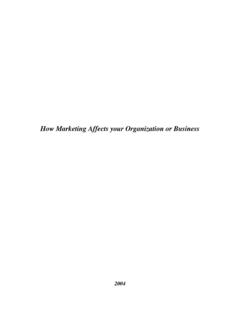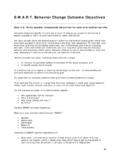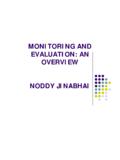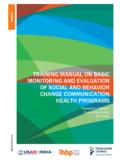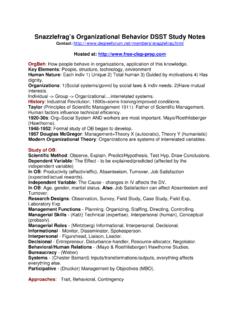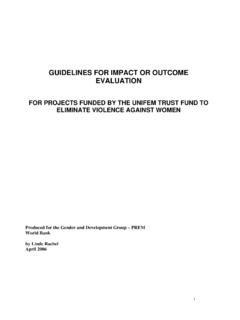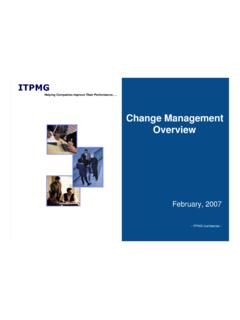Transcription of Organizational Behavior Terminology and Concepts
1 Organizational Behavior Terminology and Concepts By 1 September 04 2004 Organizational Behavior Terminology and Concepts PAGE: 1 Outline: A) Introduction: The history of performance appraisal is rather brief. Its roots in the early 20th century can be retraced to Taylor's pioneering Time and Motion studies. But this is not very useful, for the same may be articulated about almost everything in the field of modern human resources management. As a distinct and formal management procedure expended in the evaluation of work performance, appraisal really dates from the time of the Second World War - not more than 60 years ago. Yet in a broader sense, the pattern of appraisal is a very ancient art. In the scale of things historical, it might well lay arrogate to being the world's second oldest profession.
2 C) Conclusion Foreword: 360-degree feedback is a performance appraisal approach that employs input from an employee's supervisors, colleagues, subordinates-and, sometimes, even suppliers and customers. Thesis Statement: This research paper will explain the 360-degree feedback program and its apparent benefits, implementation procedures and the Organizational readiness to embark on such a process. The discussions and recordings of this paper will be limited to the scope of the literature surveyed. DATE: SEPTEMBER. 1, 04 Organizational Behavior Terminology and Concepts PAGE: 2 Organizational Behavior Organizational Behavior is the study and application of knowledge about how people, individuals, and groups act in organizations. It does this by taking a system approach. That is, it interprets people-organization relationships in terms of the whole person, whole group, whole organization, and whole social system.
3 Its purpose is to build better relationships by achieving human objectives, Organizational objectives, and social objectives. As you can see from the definition above, Organizational Behavior encompasses a wide range of topics, such as human Behavior , change , leadership, teams, etc. Since these many of these topics are discussed in other sections of this leadership guide, this section will not go into topics previously discussed. Elements of Organizational Behavior The organization's base rests on management's philosophy, values, vision and goals. This in turn drives the Organizational culture which is composed of the formal organization, informal organization, and the social environment. The culture determines the type of leadership, communication, and group dynamics within the organization. The workers perceive this as the quality of work life, which directs their degree of motivation.
4 The final outcome are performance, individual satisfaction, and personal growth and development. All these elements combine to build the model or framework that the organization operates from. Organizational Culture Basically, Organizational culture is the personality of the organization. Culture is comprised of the assumptions, values, norms and tangible signs (artifacts) of organization members and their behaviors. Members of an organization soon come to sense the particular culture of an organization. Culture is one of those terms that's difficult to express distinctly, but everyone knows it when they sense it. For example, the culture of a large, for-profit corporation is quite different than that of a hospital which is quite different that that of a university. You can tell the culture of an organization by DATE: SEPTEMBER.
5 1, 04 Organizational Behavior Terminology and Concepts PAGE: 3 looking at the arrangement of furniture, what they brag about, what members wear, etc. -- similar to what you can use to get a feeling about someone's personality. Corporate culture can be looked at as a system. Inputs include feedback from, , society, professions, laws, stories, heroes, values on competition or service, etc. The process is based on our assumptions, values and norms, , our values on money, time, facilities, space and people. Outputs or effects of our culture are, , Organizational behaviors, technologies, strategies, image, products, services, appearance, etc. The concept of culture is particularly important when attempting to manage organization-wide change . Practitioners are coming to realize that, despite the best-laid plans, Organizational change must include not only changing structures and processes, but also changing the corporate culture as well.
6 There's been a great deal of literature generated over the past decade about the concept of Organizational culture -- particularly in regard to learning how to change Organizational culture. Organizational change efforts are rumored to fail the vast majority of the time. Usually, this failure is credited to lack of understanding about the strong role of culture and the role it plays in organizations. That's one of the reasons that many strategic planners now place as much emphasis on identifying strategic values as they do mission and vision. Organizational Diversity Organizational Effectiveness and Efficiency Organizational effectiveness is defined as the degree to which an organization realizes its goals. As such, goals are the end-states that the organization strives to achieve, while the mission is the basis for the organization s existence.
7 The goals are often best reflected in the vision statement of the organization. DATE: SEPTEMBER. 1, 04 Organizational Behavior Terminology and Concepts PAGE: 4 Measurement of Organizational Effectiveness The various approaches to measuring Organizational effectiveness were based on either the output (goal approach), the inputs (system-resource approach) or the organization s transformation process (internal process approach). Each of these approaches has strengths and weaknesses, and as their shortcomings became more obvious, more integrative approaches were developed and have now gained wide acceptance. These approaches are the stakeholder and competing-values methods Goal Approach The goal approach to effectiveness consists of identifying an organization s output goals and assessing how well the organization has attained these goals.
8 This is a logical approach because organizations do try to attain certain levels of output, profit, or client satisfaction. The goal approach measures progress toward attainment of those goals.[19] System-Resource Approach The system-resource approach looks at the input side of the transformation process. It assumes organizations must be successful in obtaining resource inputs and in maintaining the Organizational system to be effective. Organizations must obtain scarce and valued resources from other organizations. From a system s view, Organizational effectiveness is defined as the ability of the organization, in either absolute or relative terms, to exploit its environment in the acquisition of scarce resources. Internal Process Approach In the internal process approach, effectiveness is measured as internal Organizational health and efficiency.
9 An effective organization has a smooth, well-oiled internal process. Employees are happy and satisfied. Departmental activities mesh with one another to ensure high productivity. This approach does not consider the external environment. The important element in effectiveness is what the organization does with the resources it has, as reflected in internal health and efficiency.[25] DATE: SEPTEMBER. 1, 04 Organizational Behavior Terminology and Concepts PAGE: 5 Stakeholders Approach Stakeholder Approach In the stakeholder (also referred to as the constituency) approach, the focus is on the Organizational stakeholders, where stakeholders are defined as any group inside or outside of the organization that has a stake in its performance. Typical stakeholders include the owners, employees, customers and suppliers; less visible stakeholders would include special-interest groups, local communities, and governments and their regulatory agencies.
10 [30] Given that stakeholders have different interests, they would define effectiveness according to their own needs and priorities. Thus while owners would like to optimize profits, employees would like their wages to be optimized, and the customers would be looking for affordable, reliable and high quality products. Competing-Values Approach The competing-values approach seeks performance indicators from all four Organizational models. Typically, it will look at the goals of human resource development from the human relations model; growth and resource acquisition from the open system model; stability and equilibrium from the internal model; and productivity and efficiency from the rational goal model. As such, this approach can be all-inclusive by capturing as many indicators as possible and mapping them accordingly; however, its main value lies in identifying the primary values which drive an organization and assists in choosing the criteria required for measuring performance in that organization.


